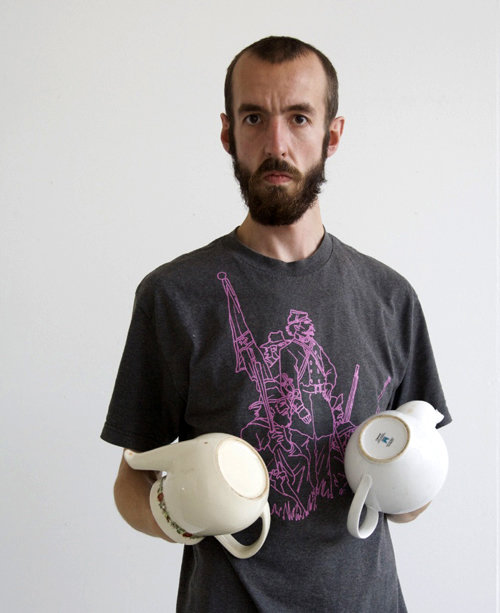Isa Andreu
Hadar Bernstein
Rachel Carey
Aline Keller
Anke Kuipers
Cornelia Heusser
Esperanza Rosales
David Stamp
Joshua Thies
Kathrin Wolkowicz
9/7/2009
neveroddoreven
Tent, Rotterdam
The exhibition is the graduation show of the Master of Fine Art Programme at the Piet Zwart Institute, a postgraduate programme of the Willem de Kooning Academy / Rotterdam University. The project takes the palindrome "neveroddoreven" as its title, because you can invest time in thinking about what it may mean, as you can try to construct implied meaning from spatially organized relations.

Isa Andreu (ES), Hadar Bernstein (IL), Rachel Carey (US), Aline Keller (CH), Anke Kuipers (NL), Cornelia Heusser (CH), Esperanza Rosales (US), David Stamp (UK), Joshua Thies (US), Kathrin Wolkowicz (DE/PL)
From 10 July to 24 August TENT. presents neveroddoreven, the graduation show of the Master of Fine Art Programme at the Piet Zwart Institute, a postgraduate programme of the Willem de Kooning Academy/Rotterdam University. The concept of the exhibition is developed in close collaboration with Bik Van der Pol, tutors at Piet Zwart Institute.
This show takes the palindrome “neveroddoreven” as its title, because – as with art and as with most group shows – you can invest time in thinking about what it may mean, as you can try to construct implied meaning from spatially organized relations. Or, you can perhaps think about the game with words or numbers that functions backwards as well as forwards.
Isa Andreu’s work is concerned with historical memory, transitory memory and the emotional perception of places that create imaginary and symbolic spaces, which are also spaces of exchange. Central to her recent work is the idea of the forgotten archive. How can the past be narrated if an archive is lost or neglected?
Hadar Bernstein has been working on architectural plans for the 'black city'. There is a legend that the 'white city', a collection of modernist buildings in Tel Aviv, has a subterranean shadow. If the white city represents the desire to transport an idea of a European, utopian modernism to the Middle East, it is in the black city that the dark engines of control turn.
Rachel Carey speaks in allegories. In her installations, humble creatures are given voices. Their meek forms cast big shadows. We were still living in caves, we were closer to monkeys, when someone said: “Bring me a flame and with my hand I will show you the world in the shadows I make.” Around about the same time people started to realize that paradise is always somewhere else.
Aline Keller has made an installation with six voices. Some of the voices seem to struggle to find a place for themselves, and they sometimes talk in non sequiturs, but together they form a choreography of voices in space
Anke Kuipers knows that one of the characteristics of the baroque is that the identities of things become indistinct. A piece of furniture, a throne for instance, unfolds onto the floor and ceiling to become architecture, the throne’s elaborate ornamentation might at some point coagulate into a sculpture, but it will always fall back into the folding. Kuipers understands that there is a space between the second and third dimensions.
Cornelia Heusser has built three stages that are stacked on top of each other. The top and the bottom are the sites of three-dimensional collages. They are spattered with textures and colours that stick to your retina like chewing gum. The third is a stage on which something has already happened or on which something is yet to happen.
Esperanza Rosales wrote a script that deals with two of the great inventions of the Romantic Movement: self-reflection and the interior monologue. The characters in her piece – that might be familiar to readers of Balzac, Shelly or Novalis – are in search of companions with whom they can share their loneliness.
David Stamp’s installation takes us on a circuit through the carnivalesque and invites us
to see just how important pointless things are. While things unravel things fall together,
and with every loop through the same circuit the scenery changes.
Recently, Joshua Thies has acquainted himself with a series of maniac visionaries such as Camp King Gillette and Elisha Graves Otis who both wanted to build their own fantastic future-worlds. The psychological skin that covers all these virtual worlds fascinates Thies.
Kathrin Wolkowicz’s recent work is concerned with the perception of time within the
media of film and the book. In Wolkowicz’s black and white 16mm silent film, text and
images create a space where past and present tenses mingle. A selection of text-based
objects chart a path for the visitor, inviting them to linger.
Promotieprize ‘09
Every year, the Stichting Promotieprijs awards the ‘Promotieprijs’ to one of the graduates of the Piet Zwart Institute. Prior winners are Katarina Zdjelar, Rafael Freyre Mendieta, Gunndis Yr Finbogadottir
Publication
The exhibition is accompanied by a publication with contributions by the artists. Design and concept: Nienke Terpsma i.c.w. Jack Henrie Fisher. Available from the reception desk at TENT.
Also
From 3 – 12 July: Piet Zwart Institute New Media Design in Centrum Beeldende Kunst Rotterdam
Image: David Stamp, Two Teapots (2oo8, variable, photograph)
Press information
Josje Stoel, communication and events +31 (0)104135498, com.tent@cbk.rotterdam.nl
Opening
Friday July 10 July, 20:00 hrs.
With a reading by Esperanza Rosales and performances by Cornelia Heusser and Joshau Thies at 21:00 hrs.
TENT. Rotterdam
Witte de Withstraat 50, 3012 BR, Rotterdam, Netherlands
Open: Tuesday – Sunday from 11:00 – 18:00 hrs.
On Saturday 25 July (Zomercarnaval) TENT. is open until 13:00 hrs. On Saturday 8 August TENT. is closed (Dance Parade Rotterdam).



